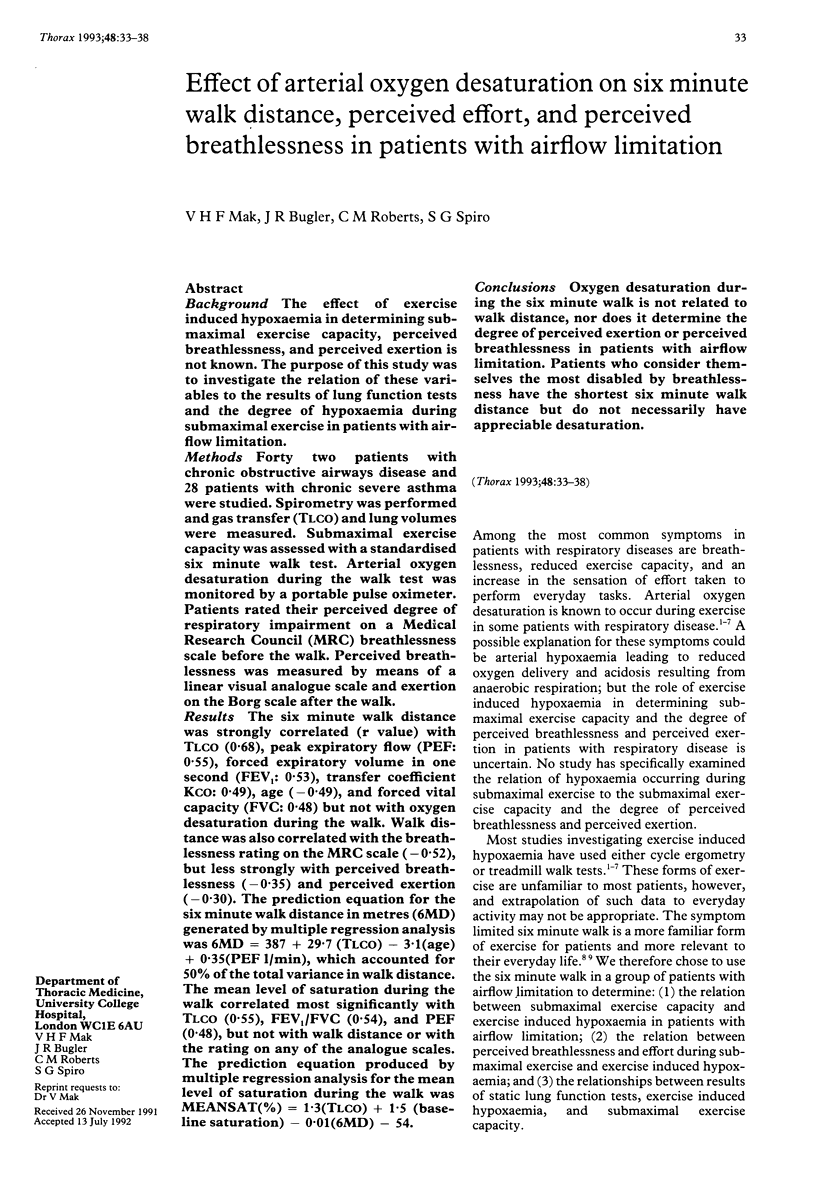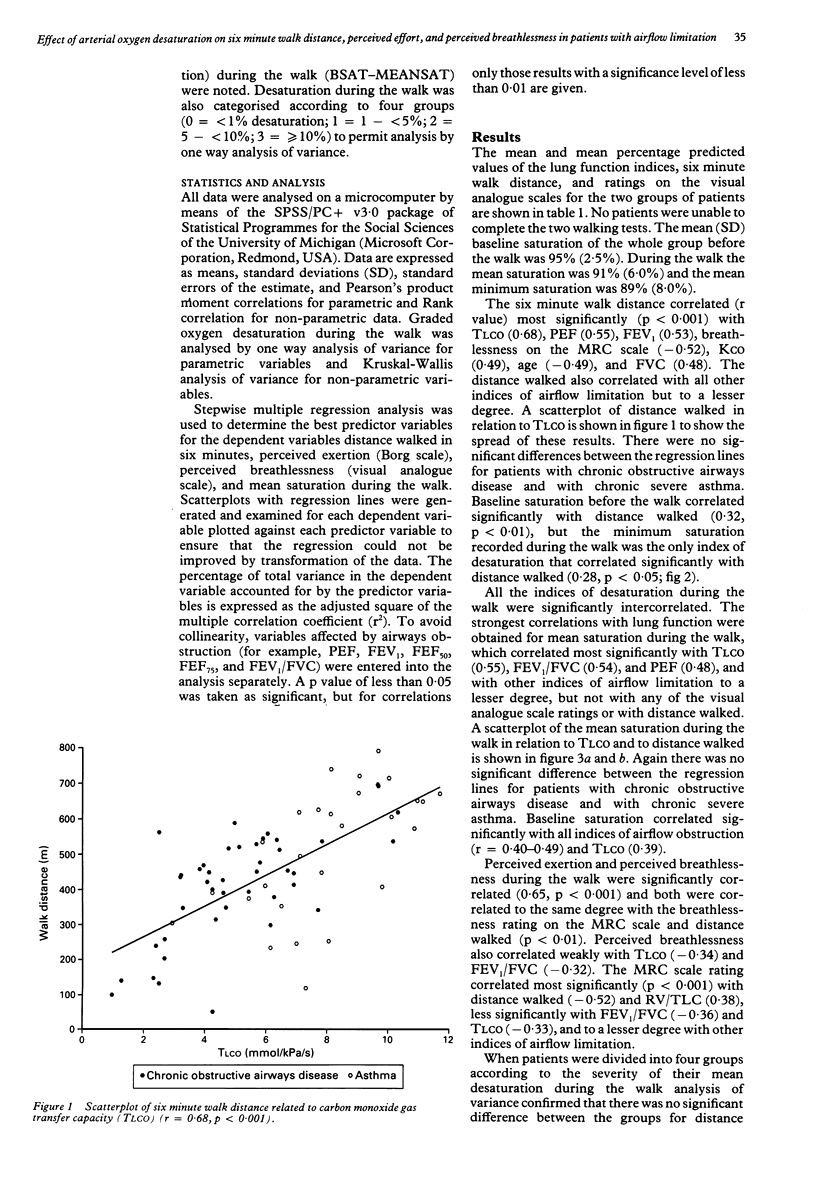Abstract
BACKGROUND: The effect of exercise induced hypoxaemia in determining submaximal exercise capacity, perceived breathlessness, and perceived exertion is not known. The purpose of this study was to investigate the relation of these variables to the results of lung function tests and the degree of hypoxaemia during submaximal exercise in patients with airflow limitation. METHODS: Forty two patients with chronic obstructive airways disease and 28 patients with chronic severe asthma were studied. Spirometry was performed and gas transfer (TLCO) and lung volumes were measured. Submaximal exercise capacity was assessed with a standardised six minute walk test. Arterial oxygen desaturation during the walk test was monitored by a portable pulse oximeter. Patients rated their perceived degree of respiratory impairment on a Medical Research Council (MRC) breathlessness scale before the walk. Perceived breathlessness was measured by means of a linear visual analogue scale and exertion on the Borg scale after the walk. RESULTS: The six minute walk distance was strongly correlated (r value) with TLCO (0.68), peak expiratory flow (PEF: 0.55), forced expiratory volume in one second (FEV1: 0.53), transfer coefficient KCO: 0.49), age (-0.49), and forced vital capacity (FVC: 0.48) but not with oxygen desaturation during the walk. Walk distance was also correlated with the breathlessness rating on the MRC scale (-0.52), but less strongly with perceived breathlessness (-0.35) and perceived exertion (-0.30). The prediction equation for the six minute walk distance in metres (6MD) generated by multiple regression analysis was 6MD = 387 + 29.7 (TLCO) -3.1 (age) + 0.35 (PEF 1/min), which accounted for 50% of the total variance in walk distance. The mean level of saturation during the walk correlated most significantly with TLCO (0.55), FEV1/FVC (0.54), and PEF (0.48), but not with walk distance or with the rating on any of the analogue scales. The prediction equation produced by multiple regression analysis for the mean level of saturation during the walk was MEANSAT(%) = 1.3(TLCO) + 1.5 (base-line saturation) - 0.01 (6MD) - 54. CONCLUSIONS: Oxygen desaturation during the six minute walk is not related to walk distance, nor does it determine the degree of perceived exertion or perceived breathlessness in patients with airflow limitation. Patients who consider themselves the most disabled by breathlessness have the shortest six minute walk distance but do not necessarily have appreciable desaturation.
Full text
PDF





Selected References
These references are in PubMed. This may not be the complete list of references from this article.
- Butland R. J., Pang J., Gross E. R., Woodcock A. A., Geddes D. M. Two-, six-, and 12-minute walking tests in respiratory disease. Br Med J (Clin Res Ed) 1982 May 29;284(6329):1607–1608. doi: 10.1136/bmj.284.6329.1607. [DOI] [PMC free article] [PubMed] [Google Scholar]
- Cockcroft A., Beaumont A., Adams L., Guz A. Arterial oxygen desaturation during treadmill and bicycle exercise in patients with chronic obstructive airways disease. Clin Sci (Lond) 1985 Mar;68(3):327–332. doi: 10.1042/cs0680327. [DOI] [PubMed] [Google Scholar]
- Cohn J. E., Donoso H. D. Exercise and intrapulmonary ventilation-perfusion relationships in chronic obstructive airway disease. Am Rev Respir Dis. 1967 Jun;95(6):1015–1025. doi: 10.1164/arrd.1967.95.6.1015. [DOI] [PubMed] [Google Scholar]
- Cotes J. E., Zejda J., King B. Lung function impairment as a guide to exercise limitation in work-related lung disorders. Am Rev Respir Dis. 1988 May;137(5):1089–1093. doi: 10.1164/ajrccm/137.5.1089. [DOI] [PubMed] [Google Scholar]
- Escourrou P. J., Delaperche M. F., Visseaux A. Reliability of pulse oximetry during exercise in pulmonary patients. Chest. 1990 Mar;97(3):635–638. doi: 10.1378/chest.97.3.635. [DOI] [PubMed] [Google Scholar]
- Guyatt G. H., Pugsley S. O., Sullivan M. J., Thompson P. J., Berman L., Jones N. L., Fallen E. L., Taylor D. W. Effect of encouragement on walking test performance. Thorax. 1984 Nov;39(11):818–822. doi: 10.1136/thx.39.11.818. [DOI] [PMC free article] [PubMed] [Google Scholar]
- Hansen J. E., Casaburi R. Validity of ear oximetry in clinical exercise testing. Chest. 1987 Mar;91(3):333–337. doi: 10.1378/chest.91.3.333. [DOI] [PubMed] [Google Scholar]
- Jones N. L., Jones G., Edwards R. H. Exercise tolerance in chronic airway obstruction. Am Rev Respir Dis. 1971 Apr;103(4):477–491. doi: 10.1164/arrd.1971.103.4.477. [DOI] [PubMed] [Google Scholar]
- Jones N. L. Pulmonary gas exchange during exercise in patients with chronic airway obstruction. Clin Sci. 1966 Aug;31(1):39–50. [PubMed] [Google Scholar]
- Kagle D. M., Alexander C. M., Berko R. S., Giuffre M., Gross J. B. Evaluation of the Ohmeda 3700 pulse oximeter: steady-state and transient response characteristics. Anesthesiology. 1987 Mar;66(3):376–380. doi: 10.1097/00000542-198703000-00018. [DOI] [PubMed] [Google Scholar]
- King B., Cotes J. E. Relation of lung function and exercise capacity to mood and attitudes to health. Thorax. 1989 May;44(5):402–409. doi: 10.1136/thx.44.5.402. [DOI] [PMC free article] [PubMed] [Google Scholar]
- Knox A. J., Morrison J. F., Muers M. F. Reproducibility of walking test results in chronic obstructive airways disease. Thorax. 1988 May;43(5):388–392. doi: 10.1136/thx.43.5.388. [DOI] [PMC free article] [PubMed] [Google Scholar]
- Lane R., Cockcroft A., Adams L., Guz A. Arterial oxygen saturation and breathlessness in patients with chronic obstructive airways disease. Clin Sci (Lond) 1987 Jun;72(6):693–698. doi: 10.1042/cs0720693. [DOI] [PubMed] [Google Scholar]
- Martin D., Powers S., Cicale M., Collop N., Huang D., Criswell D. Validity of pulse oximetry during exercise in elite endurance athletes. J Appl Physiol (1985) 1992 Feb;72(2):455–458. doi: 10.1152/jappl.1992.72.2.455. [DOI] [PubMed] [Google Scholar]
- McGavin C. R., Artvinli M., Naoe H., McHardy G. J. Dyspnoea, disability, and distance walked: comparison of estimates of exercise performance in respiratory disease. Br Med J. 1978 Jul 22;2(6132):241–243. doi: 10.1136/bmj.2.6132.241. [DOI] [PMC free article] [PubMed] [Google Scholar]
- McGavin C. R., Gupta S. P., McHardy G. J. Twelve-minute walking test for assessing disability in chronic bronchitis. Br Med J. 1976 Apr 3;1(6013):822–823. doi: 10.1136/bmj.1.6013.822. [DOI] [PMC free article] [PubMed] [Google Scholar]
- Minh V. D., Lee H. M., Dolan G. F., Light R. W., Bell J., Vasquez P. Hypoxemia during exercise in patients with chronic obstructive pulmonary disease. Am Rev Respir Dis. 1979 Oct;120(4):787–794. doi: 10.1164/arrd.1979.120.4.787. [DOI] [PubMed] [Google Scholar]
- Owens G. R., Rogers R. M., Pennock B. E., Levin D. The diffusing capacity as a predictor of arterial oxygen desaturation during exercise in patients with chronic obstructive pulmonary disease. N Engl J Med. 1984 May 10;310(19):1218–1221. doi: 10.1056/NEJM198405103101903. [DOI] [PubMed] [Google Scholar]
- Pineda H., Haas F., Axen K., Haas A. Accuracy of pulmonary function tests in predicting exercise tolerance in chronic obstructive pulmonary disease. Chest. 1984 Oct;86(4):564–567. doi: 10.1378/chest.86.4.564. [DOI] [PubMed] [Google Scholar]
- Powers S. K., Dodd S., Freeman J., Ayers G. D., Samson H., McKnight T. Accuracy of pulse oximetry to estimate HbO2 fraction of total Hb during exercise. J Appl Physiol (1985) 1989 Jul;67(1):300–304. doi: 10.1152/jappl.1989.67.1.300. [DOI] [PubMed] [Google Scholar]
- Ries A. L., Farrow J. T., Clausen J. L. Pulmonary function tests cannot predict exercise-induced hypoxemia in chronic obstructive pulmonary disease. Chest. 1988 Mar;93(3):454–459. doi: 10.1378/chest.93.3.454. [DOI] [PubMed] [Google Scholar]
- Robinson R. W., White D. P., Zwillich C. W. Relationship of respiratory drives to dyspnea and exercise performance in chronic obstructive pulmonary disease. Am Rev Respir Dis. 1987 Nov;136(5):1084–1090. doi: 10.1164/ajrccm/136.5.1084. [DOI] [PubMed] [Google Scholar]
- Stewart R. I., Lewis C. M. Arterial oxygenation and oxygen transport during exercise in patients with chronic obstructive pulmonary disease. Respiration. 1986;49(3):161–169. doi: 10.1159/000194875. [DOI] [PubMed] [Google Scholar]
- Swinburn C. R., Wakefield J. M., Jones P. W. Relationship between ventilation and breathlessness during exercise in chronic obstructive airways disease is not altered by prevention of hypoxaemia. Clin Sci (Lond) 1984 Nov;67(5):515–519. doi: 10.1042/cs0670515. [DOI] [PubMed] [Google Scholar]
- Woodcock A. A., Gross E. R., Geddes D. M. Oxygen relieves breathlessness in "pink puffers". Lancet. 1981 Apr 25;1(8226):907–909. doi: 10.1016/s0140-6736(81)91612-3. [DOI] [PubMed] [Google Scholar]
- Young I. H., Woolcock A. J. Arterial blood gas tension changes at the start of exercise in chronic obstructive pulmonary disease. Am Rev Respir Dis. 1979 Feb;119(2):213–221. doi: 10.1164/arrd.1979.119.2.213. [DOI] [PubMed] [Google Scholar]
- Young I. H., Woolcock A. J. Changes in arterial blood gas tensions during unsteady-state exercise. J Appl Physiol Respir Environ Exerc Physiol. 1978 Jan;44(1):93–96. doi: 10.1152/jappl.1978.44.1.93. [DOI] [PubMed] [Google Scholar]


